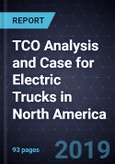Stringent Emission Regulations, Falling Battery Prices, and Lower Maintenance Costs to Drive Electrification in the Trucking Industry
This research indicates that the trucking industries in North America and Europe are increasingly facing a shortage of skilled drivers and there are concerns regarding the economic outlook and operating margins. The total cost of ownership (TCO), downtime reduction, regulation compliance, driver shortage, and equipment utilisation are emerging as decisive factors in the adoption of advanced truck technologies by fleet managers. Owing to a likely tightening of emission regulations in various regions, fleets will look to adopt fuel-efficient technologies that deliver value-added benefits such as safety and increased life. Alternative powertrains are also entering the commercial trucking space, even though fleets are apprehensive of the potential and feasibility of electrification in the truck industry due to the high prices. However, falling battery prices and growing consumer awareness are expected to encourage electrification in the industry.
Incumbents such as Nikola and Tesla have disrupted the trucking industry by announcing a slew of products in the electric truck segment, while traditional truck manufacturers have been slow to promote electrification as a viable alternative to diesel. Apart from Tesla and Nikola, players such as Orange EV and Wrightspeed too have shown potential in the vocational truck segments.
Research Highlights
The study analyses the operational costs of trucking in four different segments - urban delivery, long haul, refuse trucks, and terminal tractors/yard trucks. The models employed in the study compare the lease, maintenance, and refueling or charging costs between the diesel and fully electric variants in each of the segments. The total costs of operation are assessed for the first four years of the lifecycle. Fuel economy, battery prices, diesel costs, range, and energy efficiency of batteries are a few of the factors that are evaluated and forecast for different truck applications. After comparing the costs and the cost per mile of diesel and electric trucks, the study revealed that the electric variant of refuse trucks cost much less to operate than their diesel trucks. Among electric trucks in the other segments, yard and urban delivery trucks achieved parity in cost per mile in the short to medium term. Long haul trucks are expected to adopt electrification slower than other segments as parity is expected to be achieved only by 2027/2028. The lower operational costs of electric trucks will boost electrification in the North American medium and heavy duty segments by 2025.
As GHG emission mandates become more stringent and companies look to provide cleaner trucks, electrification will gain popularity. Falling battery prices, rapid technology developments in electrification, and huge market potential will attract new technology players and startups to the electric commercial vehicle space, while traditional truck manufacturers will be compelled to add electric vehicles to their product portfolios.
Table of Contents
Companies Mentioned (Partial List)
A selection of companies mentioned in this report includes, but is not limited to:
- Nikola
- Orange EV
- Tesla
- Wrightspeed








